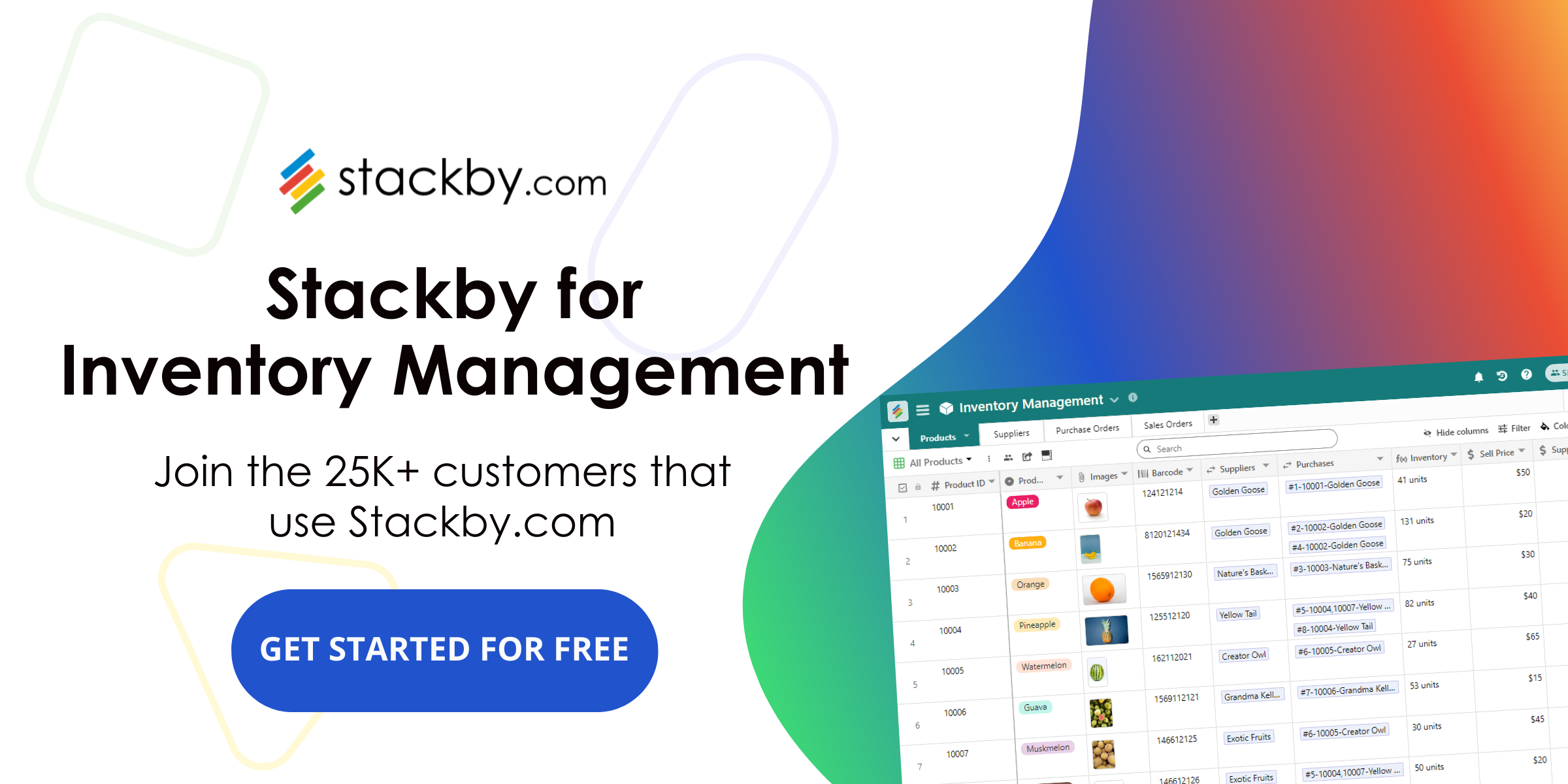How to Create an Inventory Tracker for Effective Inventory Management
Struggling to keep track of your stock or inventory and relying on manual spreadsheets or complicated ERP systems? Learn step by step on how you can build your custom inventory tracker for your business.

Effective inventory management is crucial for businesses of all sizes. It ensures that the right products are available at the right time, minimizes stockouts and overstock situations, and ultimately boosts customer satisfaction.
Managing stocks and inventory is a critical task for businesses, but it often comes with the burden of implementing costly ERP systems or relying on manual spreadsheet tracking. These traditional methods can be time-consuming, error-prone, and resource-intensive.
However, businesses now have an opportunity to explore modern solutions that offer streamlined stock and inventory management, providing accurate real-time data, automation, and cost-effective alternatives to traditional approaches.
One essential tool for efficient inventory management is an inventory tracker.
In this comprehensive blog post, we will explore the world of inventory tracking, its importance, and critical elements to include in an inventory tracker and provide a step-by-step guide on how to build your custom inventory tracker.
By the end, you'll have the knowledge and tools to master your inventory management and propel your business to new heights. So, let's get started:
What is an Inventory Tracker?
An inventory tracker is a software or system that allows businesses to monitor and manage their inventory levels, track stock movements, and gain valuable insights into their inventory performance.
It provides real-time visibility into inventory data, including stock quantities, locations, and replenishment needs. An inventory tracker helps businesses maintain optimal stock levels, streamline operations, and make data-driven inventory planning and purchasing decisions.
Importance of an Inventory Tracker
Implementing an inventory tracker offers several advantages for businesses, including:
- Accurate Inventory Control: An inventory tracker helps businesses maintain accurate and up-to-date inventory records.
It provides real-time visibility into stock levels, allowing businesses to know exactly what products they have in stock, their quantities, and their locations. - Efficient Supply Chain Management: With an inventory tracker, businesses can effectively manage their supply chain by optimizing purchase order management, reducing lead times, and improving overall operational efficiency.
- Cost Savings: By tracking inventory accurately, businesses can avoid overstock situations and prevent unnecessary storage costs. Additionally, they can identify slow-moving or obsolete inventory and take appropriate actions to minimize losses.
- Demand Forecasting: An inventory tracker provides valuable data for demand forecasting.
By analyzing historical data and inventory trends, businesses can make informed decisions about inventory replenishment, ensuring they have the right products available at the right time. - Customer Satisfaction: An inventory tracker helps businesses meet customer demands by ensuring products are available when needed. It reduces the risk of stockouts, backorders, or delayed deliveries, improving customer satisfaction.
Key Elements to Add to an Inventory Tracker
When building an inventory tracker, consider incorporating the following key elements:
- Product Information: Include details such as SKU numbers, descriptions, variants, and pricing. It allows for easy identification and organization of inventory items.
- Stock Levels: Track the quantity of each product in stock to ensure accurate inventory management and avoid stockouts or overstock situations.
- Reorder Point: Set a threshold that triggers a reorder when the stock level reaches a specific point. It helps maintain optimal inventory levels and ensures timely replenishment.
- Supplier Information: Keep track of supplier details, including contact information, lead times, and pricing agreements. It facilitates efficient communication and streamlines the purchasing process.
- Purchase Orders: Record and manage purchase orders for incoming inventory. It helps track order status, delivery dates, and supplier information, ensuring smooth order fulfillment.
- Sales Orders: Capture and manage sales orders to keep track of customer demands and ensure timely order processing and fulfillment.
- Barcode/QR Code Integration: Integrate barcode or QR code scanning capabilities to facilitate quick and accurate inventory tracking, reducing manual errors and improving efficiency.
- Locations and Warehouses: Track inventory by location or warehouse, especially if you have multiple storage areas. It allows for easy management and retrieval of items when needed.
- Reporting and Analytics: Generate reports and analytics on inventory performance, sales trends, and stock turnover. It provides valuable insights for decision-making and optimizing inventory strategies.
- Alerts and Notifications: Set up automated alerts and notifications for low stock levels, stock discrepancies, or upcoming reorder points. It ensures proactive management of inventory and prevents stockouts.
Step-by-Step Guide to Building an Inventory Tracker in Stackby
Building an inventory tracker is a systematic process that involves various steps to ensure adequate inventory management.
Real-time inventory = Purchase Orders (Items in Stock) minus Sales Orders
Follow this comprehensive guide to create an inventory tracker that streamlines your operations and optimizes stock control:
Step 1: Workflow Design
Begin by designing a workflow that outlines the entire inventory management process. Define the steps involved, from data consolidation to data reporting and automation.
a) To design an effective inventory management workflow, create tables for Products, Suppliers, Purchase Orders, and Sales Orders.
These tables capture essential information such as product details, supplier information, order details, and customer orders, allowing you to streamline inventory tracking and management processes.
b) Establish relationships between the Products, Suppliers, Purchase Orders, and Sales Orders tables using Link columns, Lookups, and Aggregation.
It enables seamless connections and accurate data retrieval, facilitating efficient inventory tracking and management.
This workflow acts as a blueprint for building your inventory tracker and ensures a structured approach.
Step 2: Data Consolidation
Consolidate your inventory data from different sources, such as spreadsheets, forms, or tools, into this centralized system.
Import the relevant information, including product details, stock quantities, and other relevant data. This step ensures that all your inventory information is accessible in one place.
You can create custom purchase order and sales order forms and bring data automatically in those respective tables and linked to the products table.
Step 3: Data Management
Organize and structure your inventory data within the tracker system. Create product categories, link tables together, and establish relationships between those tables using the Link column type. It allows for efficient data management, easy navigation, and a comprehensive view of your inventory.
Link your purchase orders and sales orders to your individual products, and create an aggregation of products in stock and products sold.
Real time inventory is nothing but products ordered minus products sold.
Step 4: Data Reporting
Configure your inventory tracker to generate meaningful reports and analytics. Utilize dashboards, charts, summary boxes and pivot tables to visualize inventory metrics such as stock levels, sales trends, and turnover rates.
These reports provide valuable insights that inform decision-making and help optimize your inventory management strategies.
Step 5: Data Automation
Identify repetitive manual processes in your inventory management workflow and automate them.
Utilize forms, connect other inventory tools like Zoho, Shopify, one or two more popular ones via Zapier, or API connectors to bring real-time orders in the orders table and automate tasks such as order tracking, stock updates, reorder point alerts, and data synchronization with other systems. Automation reduces manual effort, minimizes errors, and improves overall efficiency.
Video Guide
We have prepared a comprehensive video guide to provide you with visual guidance on building an inventory tracker. Watch the video below to gain a better understanding.
In a Nutshell
So, it is evident from this detailed guide that effective inventory management is essential for businesses to optimize stock levels, minimize costs, and meet customer demand.
By building an inventory tracker, you can gain real-time visibility into your inventory, streamline operations, and make data-driven decisions for better inventory management.
Follow the step-by-step guide outlined in this blog post to create your inventory tracker. Incorporate critical elements such as stock quantity tracking, location management, reorder point alerts, product information management, and reporting capabilities.
With a well-designed inventory tracker, you'll be equipped to master your inventory management, improve operational efficiency, and drive business success.
Thus, implementing an inventory tracker is a strategic move that empowers your business to master inventory management and stay ahead in today's competitive market.
Now, are you in search of a fantastic inventory management template? If so, look no further than Stackby. We offer several customizable templates, such as the Art Inventory Tracker Template, Office Inventory Template, and Inventory Management Template.
Choose any options that align with your unique needs to start your inventory tracking journey!


![A Simple Guide on Workflow Management Software [Updated 2024]](/blog/content/images/size/w960/2021/12/work-management-blog.png)



